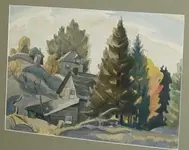I googled his history:
E. Conyers Barker............Watercolours' 'horizontal boy'
After studying with the Group of Seven, he went on to develop a style that 'extracted only the essentials -- shapes and colours' from the landscapes he favoured
By Carol COOPER, Special to the Globe and Mail Tuesday, February 3, 2004 - Page R5
Gazing at the sea in Barbados during the late seventies, artist E. Conyers BARKER had an epiphany. The watercolour painter saw bars of colour receding to the horizon and instead of recreating the scene in a traditional, realistic manner, he painted it in horizontal bands.
After years of exploration, Mr. BARKER had found his style, one that he continued to use until the end of his painting career. Its beginnings had been revealed in his early works, so much so that members of the Group of Seven, with whom he had studied, gave him the nickname "the horizontal boy."
The creator of more than 3,000 works, mostly landscapes, some of which are held by the Art Gallery of Ontario, the City of Toronto Archives, and the Hiram Walker and Weston companies among others, Ernest Conyers BARKER has died at 94.
"He took watercolour painting two leaps ahead, in the same way the Group of Seven took realism two leaps ahead," said fine-art consultant and historian David Freeman, now working on a biography of Mr. BARKER.
Although Mr. BARKER enjoyed limited commercial success and then only late in life, he got off to an early and prodigious start.
He was born in Toronto on March 18, 1909, the middle of three children of Charles, a man frequently out of work and a frustrated artist, and Gertrude, a dresser at the Royal Alexandra Theatre. Polio contracted when he was 18 months old left Mr. BARKER with one leg shorter than the other and the target of schoolyard bullies. At 11, while home from school with an injury, Mr. BARKER studied landscape paintings by Willy DRAKE, then a set painter at the Royal Alex, and works at the Art Gallery of Toronto (now the Art Gallery of Ontario) at his father's behest.
After studying at Central Technical School in Toronto, an institution known for its art training, Mr. BARKER became a commercial artist and at 18, won a competition to exhibit the Art Gallery of Toronto.
He went on to attend the Ontario College of Art and was taught there by members of the Group of Seven. In a time dominated by their work, Mr. BARKER at first painted in their tradition.
By 1930, his paintings had been shown at Toronto's Canadian National Exhibition, then a premier art venue, and in 1931 he was elected a member of the Canadian Society of Painters in Water Colour. Mr. BARKER exhibited with the group throughout the thirties as well as with the Ontario Society of Artists, the Royal Canadian Academy and at the 1939-40 New York World's Fair. Also elected to the Canadian Society of Graphic Artists during the thirties, Mr. BARKER later became its secretary and in 1944, its president.
While holding down full-time jobs as a graphic artist and at times, a sign painter, Mr. BARKER got out in his free time to sketch and paint whenever and wherever he could. Lakes, rocks, a gravel pit, barns and bushes served as his subjects, primarily in watercolour, but sometimes in oil. Often he sketched a scene from 10 to 15 times before producing a painted version. Like his Group of Seven teachers, and despite his physical limitations, Mr. BARKER took extended trips to the north, camping, canoeing to capture the rugged landscape.
At the same time as he painted realistic landscapes, Mr. BARKER explored different approaches, studying European artists and painting abstracts, before developing his horizontal style.
In 1939, seeking relief from the unhappy marriage he had made two years earlier to Margaret MUDGE, Mr. BARKER created the Nirvana paintings. He described his approach to The Globe and Mail in 1975: "I cut the sky out entirely and extracted only the essentials shapes and colours -- from the landscape. I was trying to be quiet and peaceful, but I wasn't free."
The marriage ended in 1944 and another unhappy relationship began a few years later. From 1946 to 1952, Mr. BARKER stopped painting entirely. During that time, he moved to Stayner, Ontario, north of Toronto, and began teaching in nearby Collingwood in 1952. The same year, he resumed his art. "Painting is a life force you can't contain," he told The Globe. "Creating the picture is all that matters."
Mr. BARKER's second relationship ended in 1956. In 1959, he joined the art department of the fledgling CKVR-television station in Barrie, Ontario, where he remained until his retirement 10 years later. There, known as Ernie, a derivative of his first name, he did the artwork for ads and program promotions, and was known for his health-food diet at a time when it was uncommon. Mr. BARKER outlived many colleagues who ribbed him about it.
His marriage to Hughina (Ina) McGOWAN in 1964 brought happiness and stability to Mr. BARKER's life. The seventies brought commercial success to his art.
A retrospective show of his works in 1975 at Gallery O, now called the Olga Korper Gallery, then on Markham street in Toronto, almost sold out. "Some of the paintings were from the twenties and thirties," said Ms. KORPER, the gallery's owner. "They had one foot in the contemporary world and one foot in traditional painting.... They were very experimental and progressive in many ways."
In an explication that accompanied the show, Mr. BARKER described an experience while painting: "I felt that I was only holding the brush and that an unseen power was painting the trees for me."
The retrospective was one of several shows over the next few years held at Gallery O and led to many more exhibitions, including participation in group shows at Harbourfront in Toronto, the Guild Gallery in Calgary and the Montreal Museum of Fine Art, and solo shows in Toronto and Florida.
During his retirement years, Mr. BARKER travelled to and painted in Britain, Florida and the Caribbean, including the Dominican Republic and Barbados, where he had his revelation in the late seventies. In his seventies and eighties, Mr. BARKER drove to the Prairies, where he painted for weeks at a time, camping in his van to save money.
In 1986, his Overlooking Cooks Bay, Lake Simcoe was among works by members of the Canadian Society of Painters in Water Colour chosen on the organization's 60th anniversary to hang permanently in Windsor Castle.
A deeply religious man, Mr. BARKER felt that he had been given his talent for painting by God. Serious, mild-mannered and tolerant, but highly critical of his own work, Mr. BARKER lacked the stereotypical artistic ego, according to John DELVES, a retired professor from Georgian College in Barrie and close friend of Mr. BARKER. "It was all just about what he had to do to be a better artist," Mr. DELVES said.
Mr. BARKER was elected a member of the Royal Canadian Academy in 1990 and the Society of Canadian Artists in 1995, and made a life member of the Canadian Society of Painters in Water Colour in 1991 and the Ontario Society of Artists in 1994.
By the end of his life, Mr. BARKER had lost much of his sight. He died on December 5 in Barrie, leaving his wife Ina.


